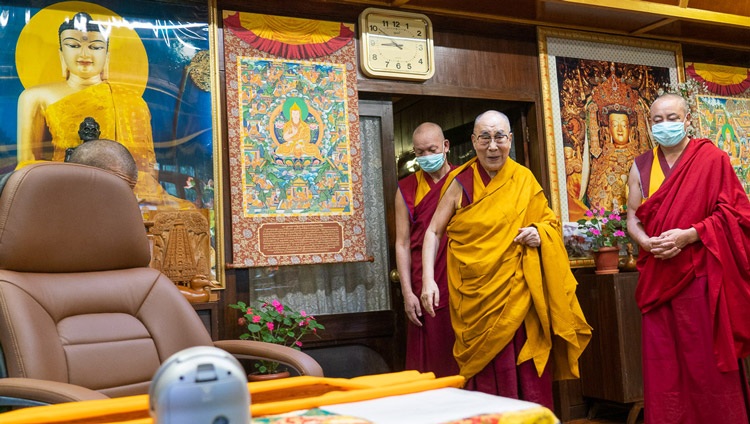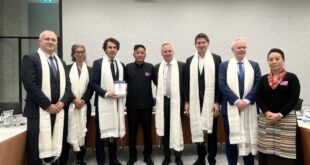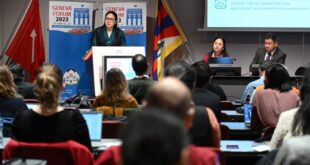“Good morning. As I’ve already mentioned, the very purpose of the dharma, like all religious traditions, is to reduce suffering and bring about happiness. As human beings we all depend on compassion from the moment we’re born. Since all religious traditions involve human beings, they all teach about loving-kindness, self-discipline, tolerance and so forth.
“One of the things that distinguishes the Indian traditions is that they include thorough explanations of the workings of the mind and emotions. The Buddha was an Indian and, after learning existing traditions, he engaged in six years of austere practice, fasting and thinking deeply. As a result, he developed a view of reality. Soon after his enlightenment, he is said to have expressed these thoughts — ‘Profound and peaceful, free from elaboration, uncompounded clear light, I have found a nectar-like Dharma. Yet if I were to teach it, there is no-one who would understand what I said; therefore, I shall remain silent here in the forest.’
“When he did begin to teach, he explained the four noble truths. Later, at Rajgir, in his second round of teachings he taught the perfection of wisdom, something only he understood. This was the teaching he described as ‘profound and peaceful, free from elaboration, uncompounded clear light, a nectar-like dharma’. The perfection of wisdom was not taught openly, but to group of select disciples. So, it was not mentioned in the public record. It was a teaching fit for those with sharp intelligence.
“The gist of what the Buddha taught in his first round of teachings has much in common with other religious traditions. The perfection of wisdom was profound and not easily understood. Because there was a risk that those following it would fall into nihilism, he gave a third round of teachings.
“The book we’re discussing, ‘Entering into the Middle Way’, is a commentary on Nagarjuna’s ‘Fundamental Wisdom of the Middle Way’. It deals with emptiness, which was the main focus of the Buddha’s second round of teachings. All Buddhists have heard of emptiness, but it wasn’t explained in detail until Nagarjuna appeared. On the basis of his investigation and realization of emptiness, he wrote ‘Fundamental Wisdom’ — a wonderful book.
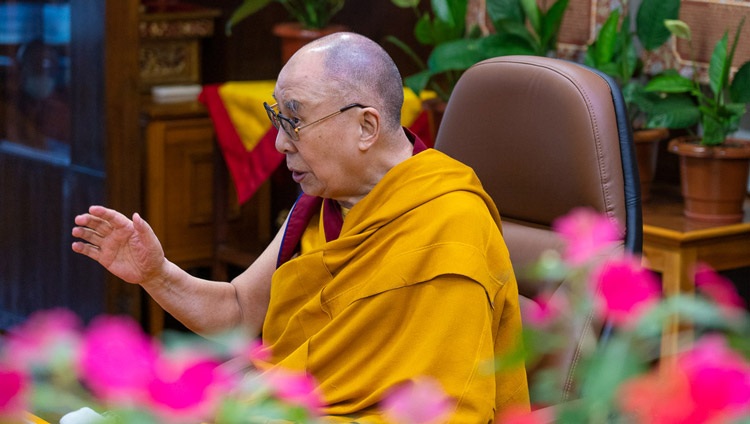
“The original Sanskrit edition still survives and I have received an explanation of it, including several variant meanings, from Khunu Lama Rinpoché. There is a verse in the text, the last line of which indicates the path through which fabrication is ended by understanding emptiness, which in turn is true cessation.
“Through the elimination of karma and afflictive emotions there is liberation.
Karma and afflictive emotions come from conceptual thoughts.
These come from mental fabrication.
Fabrication ceases through emptiness.”
His Holiness wondered whether ‘Entering into the Middle Way’ is available in its original Sanskrit edition. He suggested that it would be worth investigating. Sanskrit, he noted, is regarded as a learned language and it would be worthwhile reading both Nagarjuna’s and Chandrakirti’s texts in Sanskrit. However, he laughed as he conceded that he is too old to start learning Sanskrit now. He also lamented that he never learned Hindi properly and now it is too late for that too.
‘Entering into the Middle Way’ is one of Chandrakirti’s commentaries on Nagarjuna’s ‘Fundamental Wisdom’. It includes a criticism of the Mind Only School’s point of view, which Nagarjuna wrote nothing about, because its main proponent, Arya Asanga, lived after him.
His Holiness asked if another of Chandrakirti’s works, ‘Clear Words’ is available in Sanskrit and was pleased to hear that it is. ‘Clear Words’ is a word by word commentary on ‘Fundamental Wisdom’, whereas ‘Entering into the Middle Way’ explains what it means.
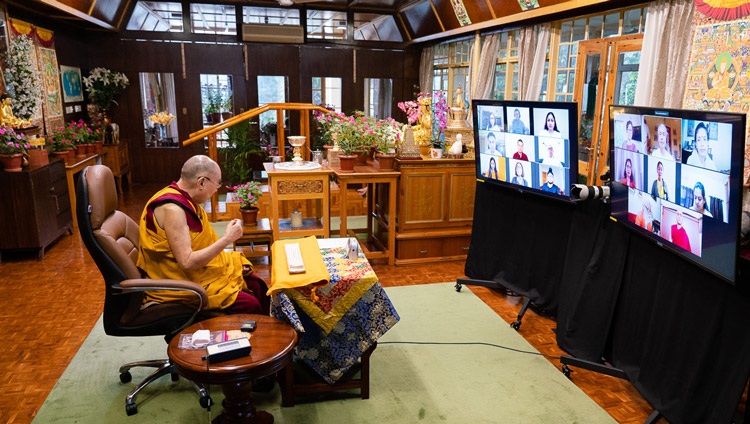
His Holiness disclosed that he is familiar with Chandrakirti’s auto-commentary to ‘Entering into the Middle Way’, and is keen to become better acquainted with ‘Clear Words’, the oral transmission of which he received from Trisur Rinpoché (Rizong Rinpoché). Consequently, he began to read it yesterday. He then quoted a Tibetan master of the past who advised that even if you will die tomorrow, it’s still worth studying today. His Holiness likened this to investing in the future.
“The reason we read these sophisticated books is because we want to avoid suffering. The ultimate source of suffering is ignorance, but it is possible to eliminate ignorance by cultivating wisdom. The ‘Sublime Continuum’ mentions that mental defilements are adventitious and can be removed.
“All wrong views and destructive emotions are based on ignorance, which involves not knowing ultimate reality. Right view is always an antidote to ignorance. The question is whether we learn about it or not. Ignorance is without foundation. Wisdom, an understanding of ultimate reality, may be difficult to acquire, but can be learned if we study hard. As Nagarjuna says, ‘karma and afflictive emotions that come about due to mental fabrication can be ended by understanding emptiness’.
“As a result of my own experience of the path, after 60 years of trying to integrate the teaching within myself, I can say that attaining cessation by following the path is possible. Progress can be achieved. But you have to study, reflect on what you’ve learned over and again, and then meditate on what you’ve understood to gain real experience of it.”
His Holiness recalled that progress on the path is indicated by the mantra of the ‘Heart Sutra’. Gaté gaté — proceed, proceed — indicates the path of accumulation, which we reach with our initial experience of bodhichitta, and the path of preparation that is associated with the initial understanding of emptiness. Paragaté —proceed beyond — represents the path of seeing, the first insight into emptiness and achievement of the first bodhisattva ground. Parasamgaté — thoroughly proceed beyond — denotes the path of meditation and the achievement of the subsequent bodhisattva grounds. Bodhi svaha — be founded in enlightenment — reveals laying the foundation of complete enlightenment.
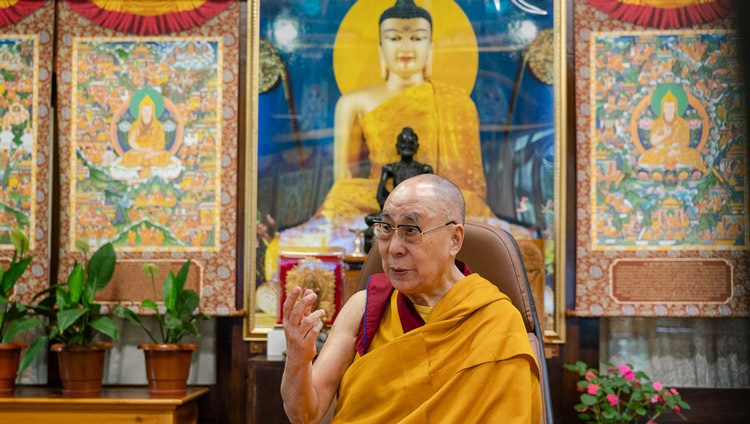
“We have been born human beings in this life,” His Holiness continued, “in a land where the teaching of the Buddha is available. We have the opportunities necessary to follow it, such as the literature contained in the Kangyur and Tengyur. Therefore, we must study, reflect and meditate to embark on the path leading to enlightenment.”
His Holiness ended his account of ‘Entering into the Middle Way’, by quoting the verse that concludes chapter six:
And like a king of swans soaring ahead of other accomplished swans,
with white wings of conventional and ultimate truths spread wide,
propelled by the powerful winds of virtue, the bodhisattva would cruise
to the excellent far shore, the oceanic qualities of the conquerors.
Responding to His Holiness’s inviting the audience to put questions to him, a monk from Bombay who studies at Sera Monastery asked how water appears as water to humans, as nectar to gods and blood or pus to hungry ghosts. He replied that while the substance in a cup may have its own potency, when different sentient beings observe it, it may appear differently to each of them.
In answer to a question about how someone experiencing acute pain should relate to the idea of its emptiness, His Holiness conceded that on a physical level there is pain. “Even if you understand that the nature of pain is empty, that doesn’t necessarily bring relief. However, when you’re in pain, you tend to develop an exaggerated view of it. If you reflect that the pain has no objective existence, that may relax its impact on your mind. If you are able to think about how things do not exist as they appear, you may be able to reduce your reaction to the pain.”
A young woman in Ladakh wanted to know how to overcome the sense that what she’s doing is only superficial when she tries to cultivate the awakening mind of bodhichitta.
“It’s really a matter of making your mind thoroughly familiar with bodhichitta until it arises effortlessly,” His Holiness told her. “Some people study the dharma for a long time and yet fail to integrated it within themselves.”
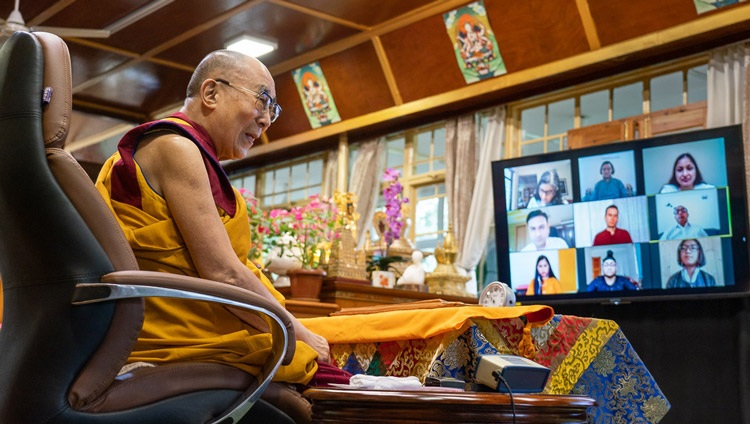
He briefly digressed to point out that the Buddha took medicine and Nagarjuna wrote about medicine, because the study of it is one of the five sciences. Another is art and crafts, which includes technology. He then advised her to recite and think about the verses for generating the awakening mind.
With a wish to free all beings
I go for refuge
To Buddha, Dharma and Sangha
Until I reach enlightenment.
Inspired by wisdom and compassion,
Today in the presence of the Buddha
I generate the mind of full awakening
For the benefit of all sentient beings.
For as long as space endures
And for as long as living beings remain
Until then may I too abide
To dispel the misery of the world.
He added another verse from ‘Guide to the Bodhisattva’s Way of Life’.
Proceeding in this way from happiness to happiness,
what thinking person would despair,
after mounting the carriage, the awakening mind,
which carries away all weariness and effort?
He further encouraged her to remember that all destructive emotions are rooted in the ignorance that is a misconception that things intrinsically exist. These stains on the mind can be overcome because the nature of the mind is clarity and awareness.
His Holiness told the next questioner that one of the keys ways to cultivate bodhichitta is the method for exchanging self with others. He clarified that this involves cherishing others as you cherish yourself, but doesn’t mean that you have to completely neglect yourself. The important thing is to rid yourself of extreme self-cherishing attitudes.
He also noted that although people say, ‘I’ll attain enlightenment after everyone else’, it doesn’t usually work out that way. He reported three ways in which bodhisattvas conduct themselves. Like a King, leading from the front; like a ferryman who goes along with everyone else and like a shepherd who comes after his flock. Working for others, His Holiness observed, takes courage.
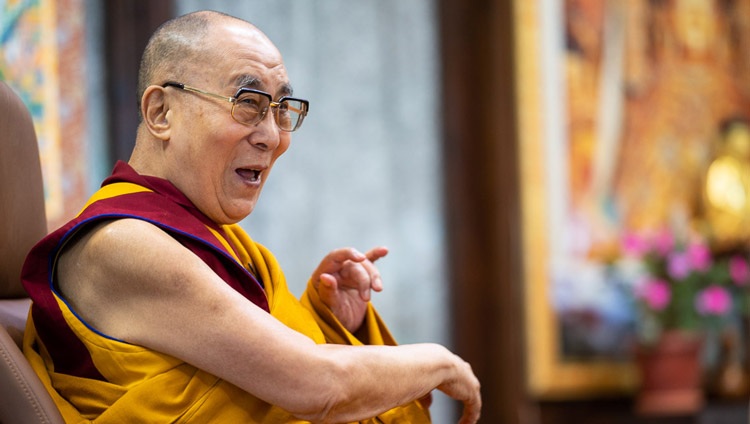
A research scholar asked if liberation is momentary or permanent, conditioned or unconditioned. She was told that the nature of liberation is the emptiness of the mind, which is not a compounded phenomenon dependent on other factors. Seeing things as if they have an essential core is a distorted view. The fact that things exist by way of dependence is natural. When we say emptiness is dependent it doesn’t mean that it is conditioned by causes and conditions. It exists by way of dependence on other factors. As Nagarjuna says, whatever is dependent is empty.
Asked to comment on the relationship between emptiness and dependent arising, His Holiness stated that when we look at an object, it appears to have some essence within it, but that is not the case. Things exist merely by way of designation. There is no essence apart from that. There are different systems of reasoning to show this like the lack of one or many and, the king of reasons, dependent arising. Emptiness means that things lack any independent existence. Jé Tsongkhapa clarifies the relation between emptiness and dependent arising as follows:
Appearances are infallible dependent arising:
Emptiness is free of assertions.
As long as these two understandings are seen as separate,
You have not yet realized the intent of the Buddha.
When these two realizations are simultaneous and concurrent,
From a mere sight of infallible dependent arising
Comes certain knowledge which completely destroys all modes of mental grasping.
At that time the analysis of the profound view is complete.
His Holiness advised a questioner who wanted to know how a lay-person could learn in a way comparable to the way monks study. He told him that because it’s necessary to cultivate bodhichitta, he should read ‘Guide to the Bodhisattva’s Way of Life’ by Shantideva. He further recommended Nagarjuna’s ‘Fundamental Wisdom’, as well as Chandrakirti’s ‘Entering into the Middle Way’ and ‘Clear Words’. In addition to these Indian books he praised five works by Jé Tsongkhapa: the ‘Special Insight Section of the Great Treatise on the Stages of the Path to Enlightenment’; the ‘Special Insight Section of the Medium-length Treatise on the Stages of the Path’; the ‘Illumination of the Thought’; the ‘Ocean of Reasoning’ and the ‘Essence of Good Explanation’. It is said that if you read these once you gain one insight; if you read them ten times you gain ten insights.
“If you read and study these books,” His Holiness averred, “you’ll acquire confidence in the Middle Way view.”
Asked his advice for dealing with difficulties in times of distress, His Holiness emphasized the need not to feel demoralized. He stressed how important it is to be determined to follow what the Buddha taught, thinking, ‘When else will I be able to pursue the teaching if not now?’ The crucial point is to integrate the teachings within yourself.
A questioner who wanted to know about the different philosophical views that culminate in the Consequentialist Middle Way view was directed to read Jamyang Shayba’s ‘Great Exposition of Tenets’, a large book that is available in English.
Dr Anita Dudhane thanked His Holiness for this virtual series of teachings on behalf of the Nalanda Shikshas. She also thanked him for his kindness in teaching them in a variety of places in India, in Dharamsala, Bombay, Sankasya and Bodhgaya, since 2012.
His Holiness replied, “We’ve had to meet this way because of the pandemic. However, I hope that by the end of this year or next year, things will have improved. I’m eager to go to the Thekchen Chöling Tsuglagkhang again. And I hope that at the end of this year I may be able to go to Bodhgaya to teach.
“I expect this body to hold up for the next 15-20 years and in that time I’m determined to talk and talk. The purpose of my own practice is to share what I’ve learned with more people. Thank you.”
